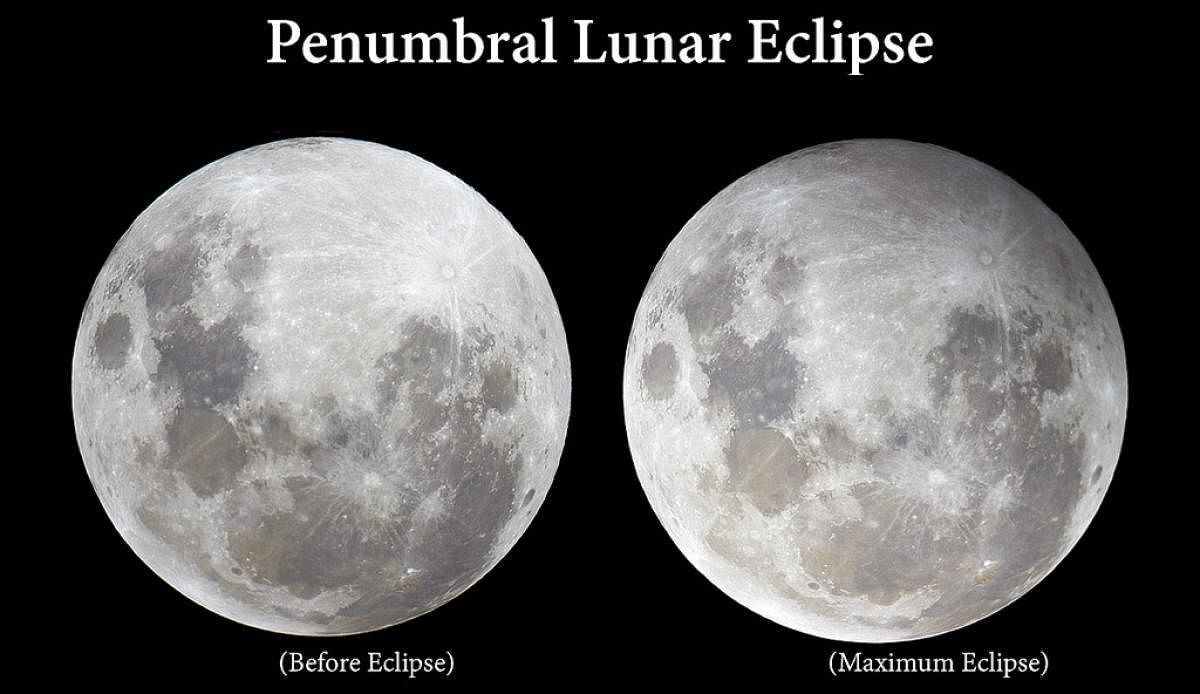

A couple of years ago, I received a phone call from a senior citizen from Udupi. “What went wrong with the moon yesterday?” he asked. He had been watching sunrise and sunset for decades and that particular evening he saw the moon rise at sunset, as happens on every full moon day. But that was not the question. The southern tip of the moon appeared black as though smeared with soot. The sky was absolutely clear and there were no clouds. He watched the moon rise higher and higher and the soot-like thing disappeared by about 7:30 pm. He wanted to know what exactly happened.
It was a penumbral eclipse and only a keen observer like him could have identified the change.
We all know that lunar eclipse is an event when the moon passes through the shadow of the earth. Thus the bright full moon will gradually fade, assume copper colour and sometimes become dark. We also know that the shadow has two parts — the darker central portion called the umbra and the slightly lit portion called penumbra. The eclipse begins when the moon enters penumbra. Since the decrease in brightness is barely recognisable the eclipse “officially” commences only when it enters umbra.
There are occasions when the moon will pass through only the penumbra and not the umbra, which are of interest to astronomers. With modern gadgets like camera and light meters, it is possible to now ‘see’ the penumbral eclipse.
Astronomers developed keen interest on watching the penumbral events only about 100 years ago. A paper published in 1903 reported that when the moon occulted (passed in front of) the bright star Spica (Chitra), observatories recorded a dip in brightness of the moon about an hour before it completely covered the star, expected as a consequence of the penumbral shadow. That appears to be the first record from an observatory on a quantitative estimate of the decrease in brightness.
Hues of a shadow
In 1926, many observatories in Europe organised coordinated observations and the penumbral passages were recorded. The campaigns continued with debates on its visibility to the naked eye. Subsequently, even amateur astronomers began observing the penumbral passages.
Generally, representative images of lunar eclipse put a sharp boundary between the umbra and the penumbra. In reality, it is not so well defined as in the case of the shadow of the moon (during solar eclipse). The refraction and scattering of the sunlight by the earth’s atmosphere renders the boundary as a fuzzy band. This can be easily recognised in the partial phases of a total eclipse. The edge of the moon in umbra is dark, the edge which is penumbra is grey while there is gradation of colour in between. The boundary cannot be defined sharply. As time progresses, the entire disc of the moon goes into the umbra. But it is not very difficult to identify the non-uniform distribution of light.
That brings us to the question of how to fix the boundary. This was a puzzle for the astronomers of the past. A geometrical derivation of the limit was devised and if the moon passed within this limit it was declared as an eclipse. Since there was a small variation owing to orbital variations, two such limits were drawn up. Many Indian (Hindu) astronomy texts discuss these limits. It was the task of the astronomer to calculate the instantaneous values and verify the visibility. Since the procedures of these calculations have been evolving over the centuries, the corrections were applied after every eclipse. Thus there is a scope that some eclipses which are marginally penumbral have been observed and recorded in earlier times.
Ancient records
It is well known that eclipses were occasions for releasing grants to scholars, temples and the like. Such records have mentioned the visibility of eclipse while as per today’s estimate they were penumbral. Like the gentleman from Udupi, these experts might have actually seen the tip of moon’s disc engulfed in the darkness of the shadow.
Varaha Mihira’s Pancha Siddhanta, written in 6th century, clearly defines that if the fraction of the moon engulfed in shadow is 1/16, it can not be called an eclipse (the corresponding number for the sun is 1/12). The passage through penumbra is declared Deepti Hrasa — decrease in brightness.
The earliest inscription of this category is dated 660 CE on a copper plate. As epigraphists try to decipher the dates written down in the inscriptions, the confusion about fixing the penumbral eclipse becomes very obvious. The extrapolation of the methods in use today will declare a particular date as no eclipse, while the inscriptional record states the contrary. This is indeed the situation with the eclipse of July 30, 1018. Similarly the eclipse of November 1322 also is penumbral further confirmed by the mention of star Rohini. We have found many such instances over these 1500 years and the latest is dated 1857 from Shravanabelagola.
The discussion on these ‘non-eclipses’ is relevant in the context of the forthcoming eclipses in 2020. All four of them are penumbral. The two solar eclipses adjacent to them are total. There was a campaign in 1941 when the situation was exactly similar — 4 penumbral eclipses and 2 solar eclipses. However, the follow up of the campaign is not available most probably because of the ensuing World War II.
So, we turn to the question — will we see the eclipse on January 10 and June 5? (The other two on July 4 and November 29 are not visible from India). We just need to go out and take a look at the moon. Let us see if we can identify the slight darkening at its southern tip.
(The writer is former director, Jawaharlal Nehru Planetarium, Bengaluru)